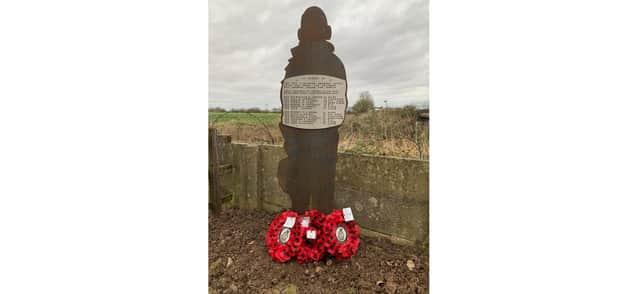New Memorial at Fulstow for two Lancaster Bomber Command Crews 80 years on.


Eighty years on, a service will be held in Fulstow today (December 24) at noon to remember the young men who perished that evening.
A memorial has been installed at the approximate site of the collision. Funds have been raised by the Annual Armistice lunch in Fulstow Village Hall, where profits were donated to The Royal British Legion and towards this new memorial. Sponsors have also been very generous with aid to the funding - Dave Starling, Ed Timmins of Timmins Engineering and mostly from Timmins Will, who has been the wing man to the organiser; Mark and Shaun Hyde of MHME Lincolnshire helping with cutting of Memorial; Heelgate Farm for allowing their land to be used; Tommy Schneider of Nordic Seafoods Denmark for seafood every year; Robin Beecroft for artwork creation DPT; Nick Hopper and Louth Building Supplies Ltd; Cool Air Logan Lincoln and mostly the residents of Fulstow, who every year turn out and support events for the upkeep of the current memorial to the Fallen of Fulstow and this new
memorial.
Advertisement
Hide AdAdvertisement
Hide AdThe two Lancaster bombers were part of a force of 379 aircraft sent to attack Berlin that night. Sixteen failed to return, though German night fighter pilots reported that poor weather conditions over the continent had made interceptions awkward.
They had roared down the runway at RAF Grimsby, which is crossed by the A16 Louth – Grimsby Road at Holton Le Clay, the Pilot concentrating on keeping the aircraft steady while the Flight Engineer held the throttles fully open against the stops. The four Rolls Royce Merlin engines, each developing 1 390-horsepower, lifting the aircraft off the ground at about 120 knots.
A Lancaster bomber bound for a distant target like Berlin, a return flight of about 7 hours, would normally be carrying 2 154 gallons of fuel, in addition to a mixed bomb load of around 10 000 lbs, making an all-up weight of about 30 tons. It is interesting to note that many of the young captains of these aircraft had yet to learn to drive a car. The crew of 7 were all volunteers, with the mix of British and Commonwealth personnel on these aircraft quite typical. Bomber Command crews were probably the most highly trained of all of Britain’s fighting forces.
The heavily laden aircraft normally took around 40 minutes to reach operational altitude of 20 000 feet, conserving fuel for the long trip ahead. RAF reports show the night sky over Lincolnshire on 23rd December 23 1943 to have been clear and starlit. For whatever reason, ED730 and ND 327 suffered a major collision at 12 000 feet over Fulstow. The aircraft blew up in mid-air, with wreckage coming to earth over an area of some four square miles, much of it along the canal.
Those remembered are:
Advertisement
Hide AdAdvertisement
Hide AdFlt Sgt William R. Cooper, age 21, PilotSgt Alan R. Laurence, age 21, NavigatorSgt Gordon W. Claydon, age 20, Flt EngrSgt George W. Guest, age 20, Bomb Aimer, CanadianSgt Robert W. Theobald, age 20, W/OSgt Joseph A. Jordan, age 21, A/Gnr, CanadianSgt Jack Rawson, age 31, A/GnrSgt Hubert F. J. Woods, age 21, PilotSgt David G. Davies, age 22, Flt EngrSgt Montague E. Giles, age 22, NavigatorFlt Sgt Joseph R. E. Legere, age 24, Bomb Aimer, CanadianSgt Leonard F. Wright, W/OSgt John C. Atherton, age 30, A/Gnr, AustralianSgt John McConnell, age 19, A/Gnr
Bomber Command crews had an operational tour of 30 missions. In 1943, on average, out of every 100 men, 55 were killed, 4 injured, 12 parachuted over Europe and became prisoners of war, 2 parachuted and evaded capture returning to the UK, 27 survived the tour.
During World War Two, Bomber Command suffered 58,000 dead, plus 20,000 wounded. They dropped 2,700,000 tons of bombs on Germany. German civilian deaths as a result of the RAF’s night area bombing are hard to calculate, but are probably in excess of 300 000.